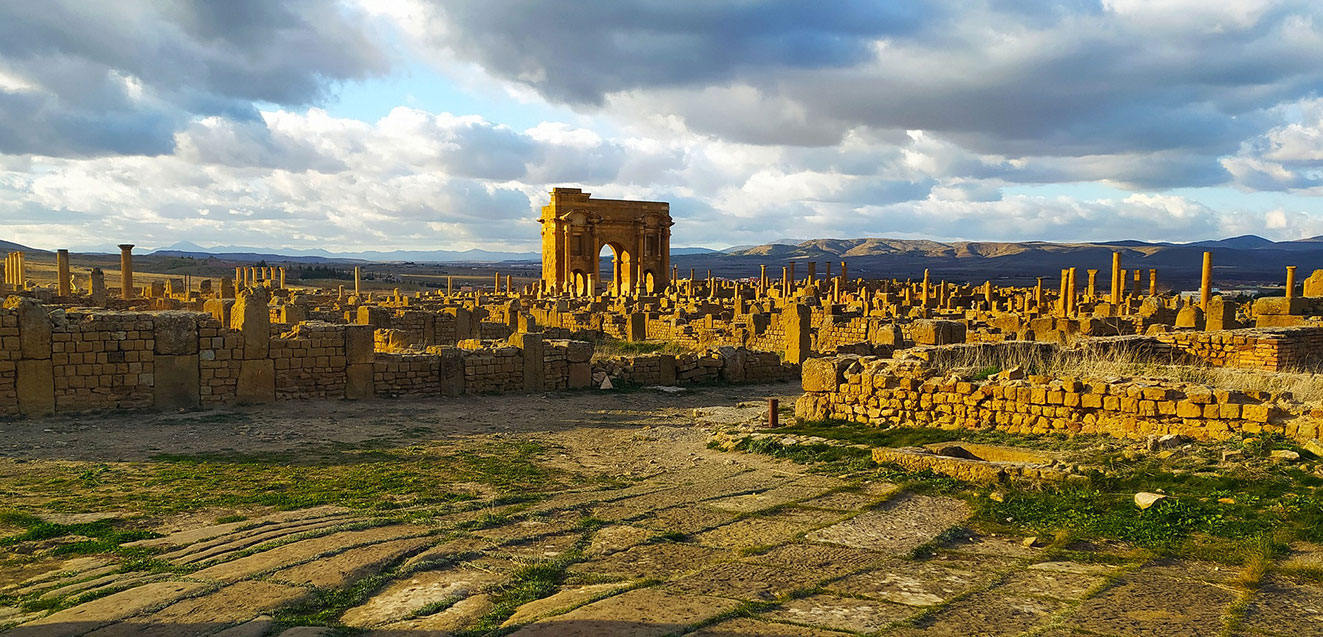The Top 5 Algeria UNESCO Sites

Algeria has seen a fair share of conflict over its long and complicated history, creating a crossroads of cultures that’s astonishingly and compellingly complex. This north African country is home to seven distinct UNESCO World Heritage sites, an impressive array for such an off-the-radar destination. On GeoEx’s small group trip, Algeria’s Shifting Sands, you’ll have the opportunity to explore five of these monumental sights, which together display architectural influences of centuries of exploration, persecution, and conquest. With travel to Algeria reopened, now’s an ideal time to learn more about these remarkable ancient wonders.
Tipasa: Coastal Colony of Many Empires

Widely considered to be one of the most remarkable archaeological complexes in northern Africa, Tipasa’s range of ruins includes stunning examples of Phoenician, Roman, early Christian, and Byzantine architecture that span from the 6th century BCE all the way until the 6th century CE. Perched on three small hills overlooking the Mediterranean Sea, this remarkable blend of histories is displayed in everything from the remains of a Roman amphitheater, to a multicultural necropolis that’s one of the oldest and most extensive remnants of the Punic world.
Tipasa began as a trading post and port for Western Phoenicians. Later, Roman emperor Claudius turned it into a military colony. As Christianity spread rapidly from the 3rd to the 4th centuries CE, religious buildings began popping up as well. Today’s ruins include the remains of three distinct churches—the Great Basilica and Basilica Alexander, both on the site’s western hill, and the Basilica of St. Salsa on Tipasa’s eastern hill—as well as the mosaic-covered stone burial sites that surround them.
There are also monuments belonging to the area’s indigenous people, including the nearby royal mausoleum, Kbor er Roumia. This circular stone monument was the original resting place of Cleopatra and Mark Antony’s only daughter, Queen Cleopatra Selene II.
Djémila: Roman Stronghold in the Mountains

Located 2,953 feet above sea level near Algeria’s northern coast, Djémila is home to some of northern Africa’s best preserved Roman ruins. Emperor Nerva first built it as a military garrison, then known as Cuicul, in the first century CE. However, what’s truly extraordinary about this mountain village is that those constructing it did so under the physical constraints of a mountain locale, aligning each street perfectly with the undulating landscape. Its vast remains include temples, triumphal arches, and even houses, as well as a stunning array of mosaic pavings that depict scenes from everyday life.
Timgad: Ancient City of Arches and Columns

Make no mistake: Timgad is huge. It’s also breathtaking and beautifully maintained: an ancient wonder where you can meander along well-preserved tiled streets and visit precise, grid-laid ruins that range from a semi-circular library to the almost intact Trajan arch, which was part of the city’s western gate. There are even the remnants of a bordello.
Roman emperor Trajan built Timgad in 100 CE. as both a military settlement and a bastion against Berber invasions, and it once housed approximately 17,000 residents. In addition to being an excellent example of ancient Roman urban planning, it also boasts a stellar setting on the slopes of the Aurès mountains in the country’s northeast.
Kasbah of Algiers: Historic Seaside Trading Post

Algiers spreads around a large crescent bay overlooking the Mediterranean Sea, and the densely packed whitewashed walls and narrow, winding streets of its kasbah are at its heart. Built along a hillside, mostly between the 16th and 18th centuries, this old quarter was once home to pirates and stood at the trailhead of the trans-Saharan caravans. It’s brimming with both Phoenician and Ottoman architectural styles, including the remains of grand palaces and the hilltop citadel. It’s also where you’ll find many of Algiers’ most prominent buildings, including mosques such as El Kebir, the oldest mosque in the region.
M’Zab Valley: Desert-Dwelling Community

Tucked away in the northern Sahara desert, the isolated M’zab Valley is a sight to behold. This 11th-century settlement is made up of the five distinct ksours, or fortified cities: El-Atteuf, Bounoura, Melika, Ghardaïa (the largest), and Beni-Isguen, each one filled with its own pastel-colored buildings and a central mosque, and set upon its own separate rocky outcrop. Indeed, M’zab is flawlessly adapted to the desert environment, going so far as to feature palm groves to give local residents cool reprieve during the sweltering summer months.
Due to its superb planning, things in the M’Zab Valley operate today just as they have for centuries, so much so that this traditional Mzabite pentapolis feels almost frozen in time. It’s a prime model of communal living, not to mention a wonderful example of urban design.
* * * * *
To see these incredible UNESCO World Heritage Sites and many other Algerian historic sites and cultural treasures, join one of GeoEx’s small group departures. To learn more or to reserve your space, call our travel experts at 888-570-7108.

